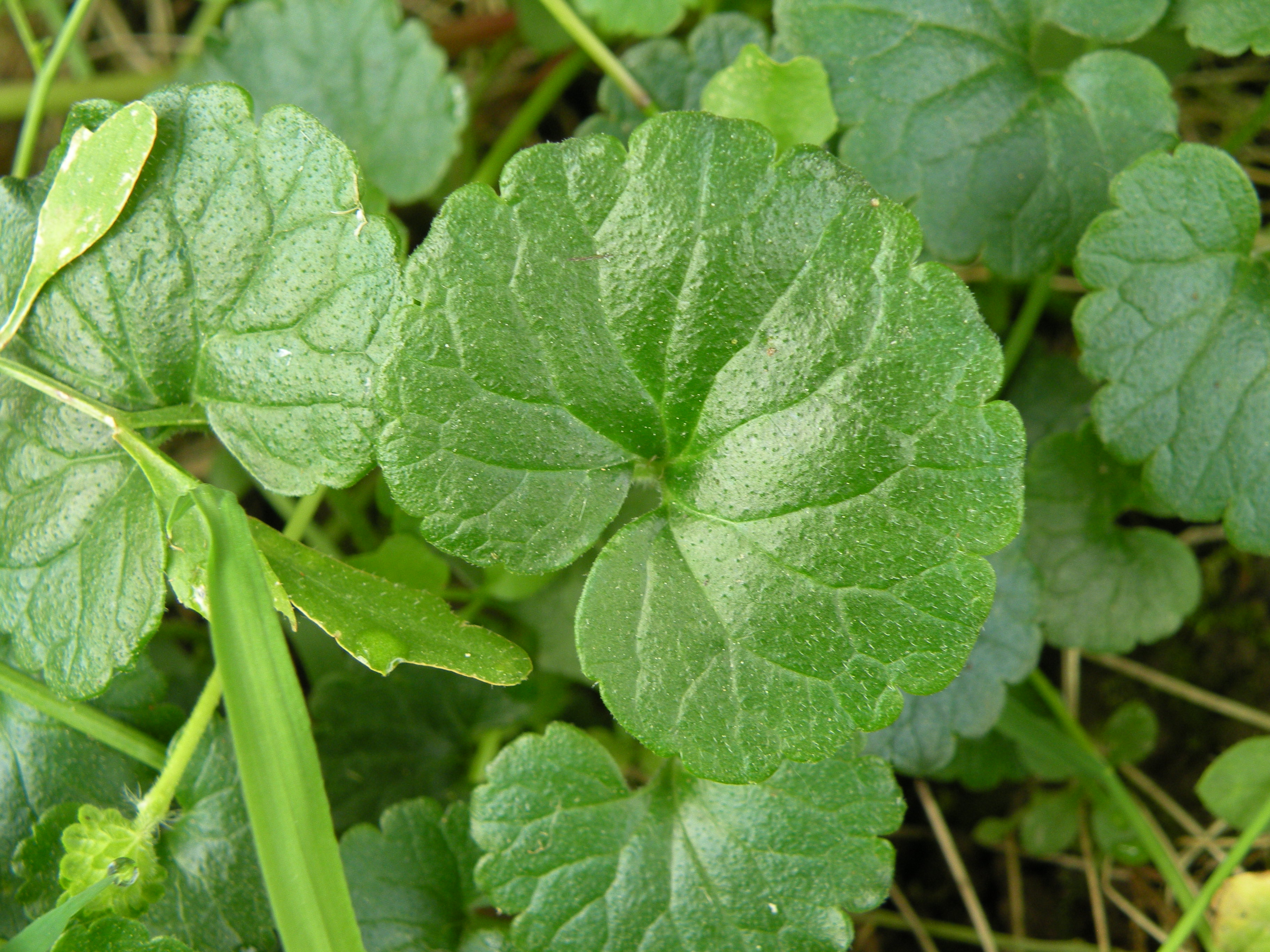Ground-Ivy (Glechoma hederacea)
Family:
Mint Family (Lamiaceae)
Other Names:
Glecoma hederacea, Nepeta hederacea, alehoff, cat ivy, cat's-foot, creeping Charlie, creeping jenny, crow victuals, field balm, gill, gill-go-by-the-hedge, gill-over-the-ground, gillale, ground joy, hayhofe, haymaids, hedgemaids, hove, lizzy-run-up-the-hedge, robin-run-in-the-hedge, run-away-robin, tun hoof, tunhofe, turnhoof, wild snakeroot.
Origin and Distribution:
Ground ivy originated in Europe and is currently distributed all over Europe and Asia. Early settlers brought the plant to North America after which it spread throughout northeastern U.S. and southern Canada. Today in the U.S., it grows abundantly within an area located east of Colorado and north of Georgia. The species is naturalized throughout Ohio. It can be found in waste areas, ditches, roadsides, pastures, orchards, open woods, agricultural fields, and is especially troublesome as a weed in lawns. Ground ivy thrives in damp, rich soils and shady places but will grow in full sun.
Plant Description:
Ground ivy is a perennial with creeping stems that sprawl over the soil surface forming a thick mat and crowding out other plants. Ground ivy has a typical mint-like appearance with square stems and 2 leaves at each node. It can be distinguished by its sprawling growth, kidney-shaped leaves that have scalloped edges and attach to stems by way of long leaf stalks (petioles), and purplish-blue flowers located in whorls of 2 to 6 in leaf axils on short, upright stalks. It emits a somewhat disagreeable minty odor when crushed. Although the plant produces seeds, the principle method of reproduction is vegetative by way of creeping stems.
Root System:
Roots are shallow, fibrous, and form at the base and at leaf nodes on the stem.
Seedlings and Shoots:
Seedlings are seldom observed. Leaves on young shoots are opposite (2 leaves per node), kidney-shaped, and have scalloped edges similar to those of older leaves.
Stems:
Ground ivy produces numerous slender stems that creep along the soil surface growing up to 30 inches long and forming a tangled mat. At the axils of stems are hairy, upright flower stalks that generally do not grow more than 8 inches tall. Also roots form at nearly every node.
Leaves:
Leaves are opposite (2 leaves per node), 1/2 to 1 inch wide, round to kidney-shaped, and have scalloped edges. When growing in partial shade, leaves are usually deep green, but they may be reddish if located in full sun. Visible on leaves are veins that radiate outward from a common point like fingers. Leaves attach to stems by way of long petioles.
Flowers:
Flowers are 1/2 to 1 inch long and purplish-blue. They consist of 5 petals united into a 2-lipped tube consisting of an upper lip with 2 shallow lobes and a lower lip with 3 larger lobes. Flowers are located in whorls of 2 or 6 in upper leaf axils on short, upright stalks formed at the nodes of creeping stems.
Fruits and Seeds:
Ground ivy produces pods with 4 nutlets that are dark brown and have a white spot at their base. Nutlets are egg-shaped, smooth, and have 1 rounded and 2 flat sides.
Similar Species:
Ground ivy can be confused with several other weedy species including common mallow (Malva neglecta), which has round stems and only 1 leaf per node. Red dead nettle and henbit (Lamium purpureum and L. amplexicaule) are winter annuals that usually flower very early in spring. Although their square stems and the shape of their flowers resemble those of ground ivy, their stems do not creep along the ground rooting at the nodes.
Biology:
Flowers bloom from March through June. In England, this plant is considered desirable and allowed to grow as a flowering ground cover; it is regarded as a weed in the U.S. where much effort is spent eradicating it from lawns. It is impossible to remove ground ivy by digging. Applying herbicides may kill established plants, but new plants will germinate from seeds stored in the soil. The only sure method of controlling ground ivy is to remove the top-layer of soil containing roots and seeds.
Toxicity:
Livestock can be poisoned by ground ivy, but most animals do not like the taste and avoid eating the plant. However, ground ivy ingested in large amounts either fresh or as hay is toxic to horses. Signs of poisoning include salivation, sweating, and difficulty breathing. Fatalities are rare.
Facts and Folklore:
'Glechoma' was derived from 'glechon', which is Greek for mint or thyme.
'Hederaceae' is Latin meaning 'ivy-like' and probably refers to either the leaf shape or creeping habit of the weed.
Ground ivy was used to flavor beer until it was replaced by hops. The common name 'alehoff' was derived from the old English word meaning 'ale ivy', and 'turnhoof' was derived from 'tun' meaning 'to tipple'. The common name 'gill' comes from the French 'guiller', which means 'to ferment'.
Ground ivy has long been used as a medicinal plant. The tea was an ancient all-purpose drink. Herbalists believed it had a cleansing effect on lungs, kidneys, stomach, and bowels. The sap of ground ivy, applied externally, is reported to be good for a black eye.
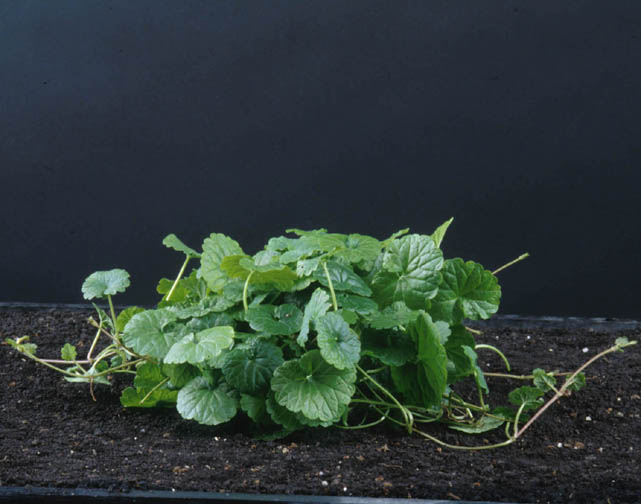
Ground ivy seedling.
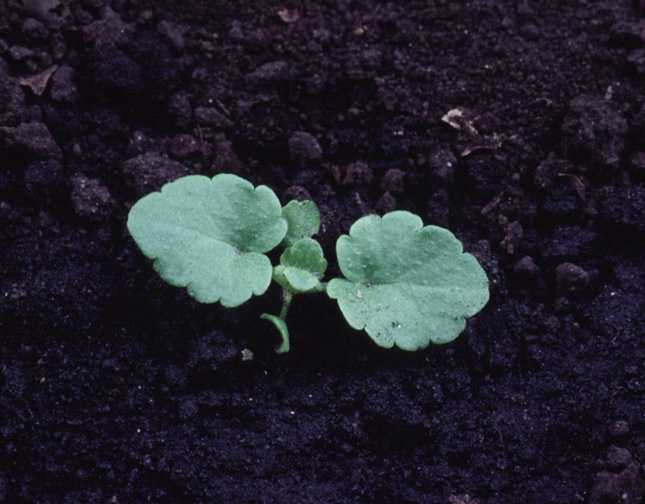
Ground ivy seeds.
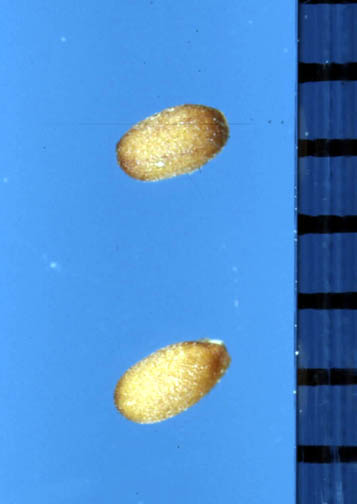
Ground ivy roots at nodes.
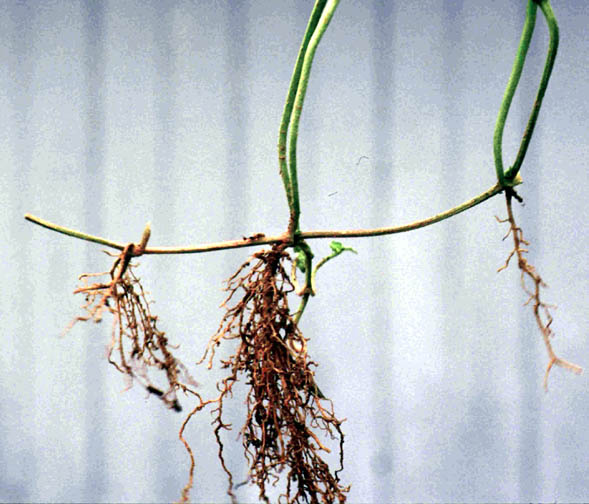
Ground ivy has a more upright growth habit if it is not mowed.
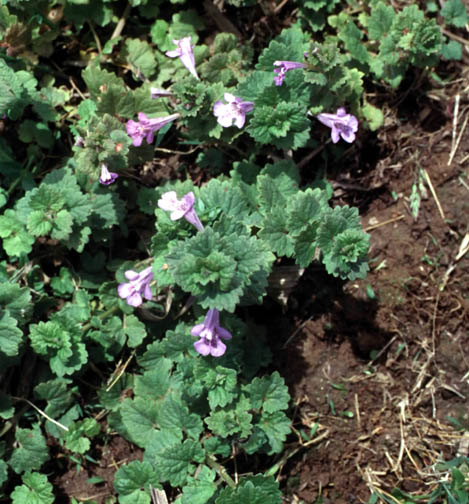
Ground ivy flower is typical two-lipped mint flower; note square reddish stem.
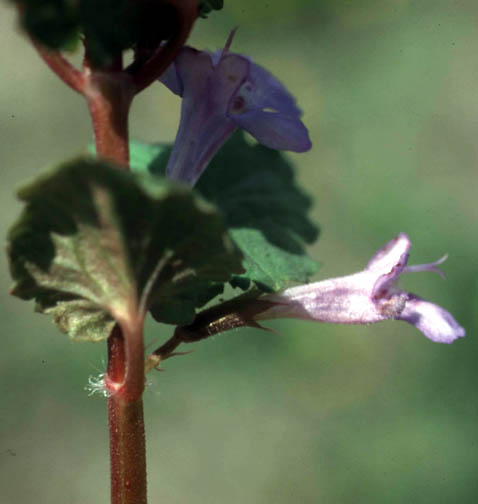
Ground ivy patch in bloom, showing creeping growth habit.

Almost-round scalloped leaf of ground ivy.
